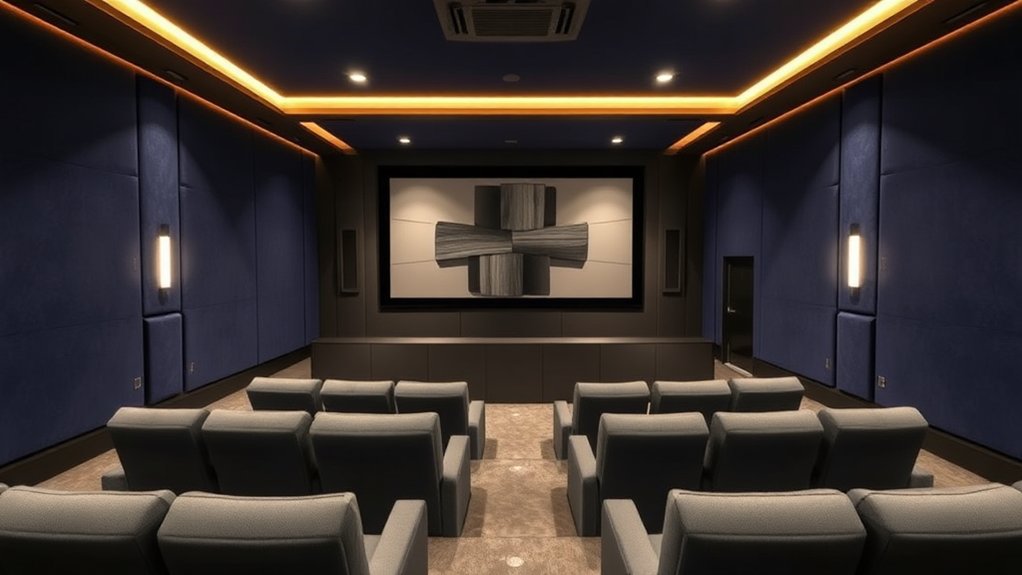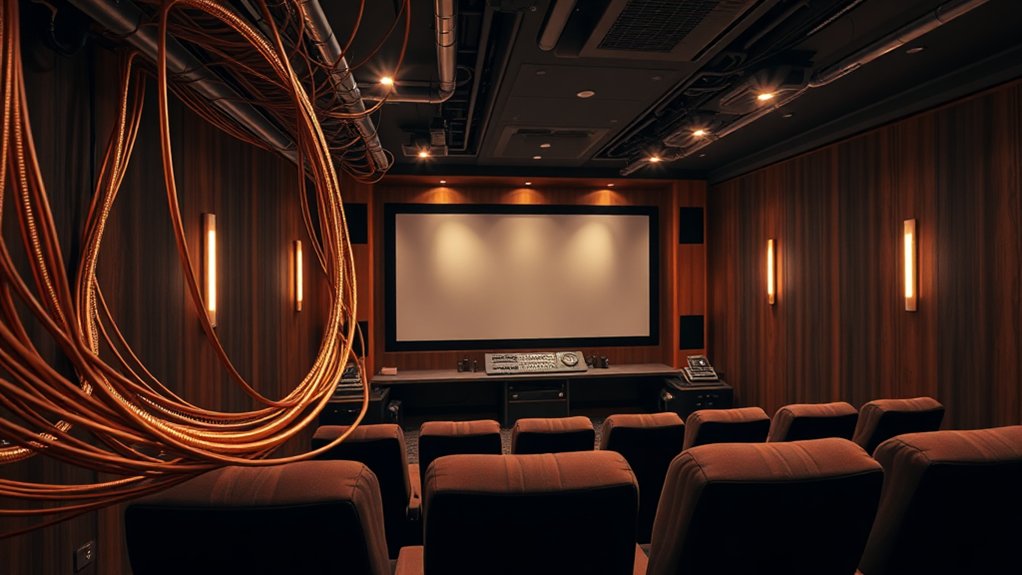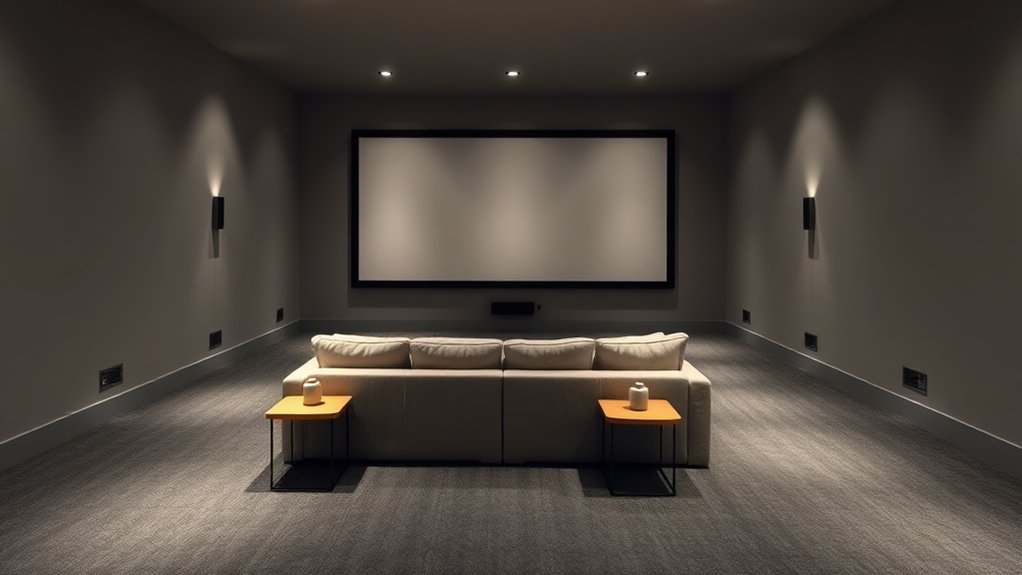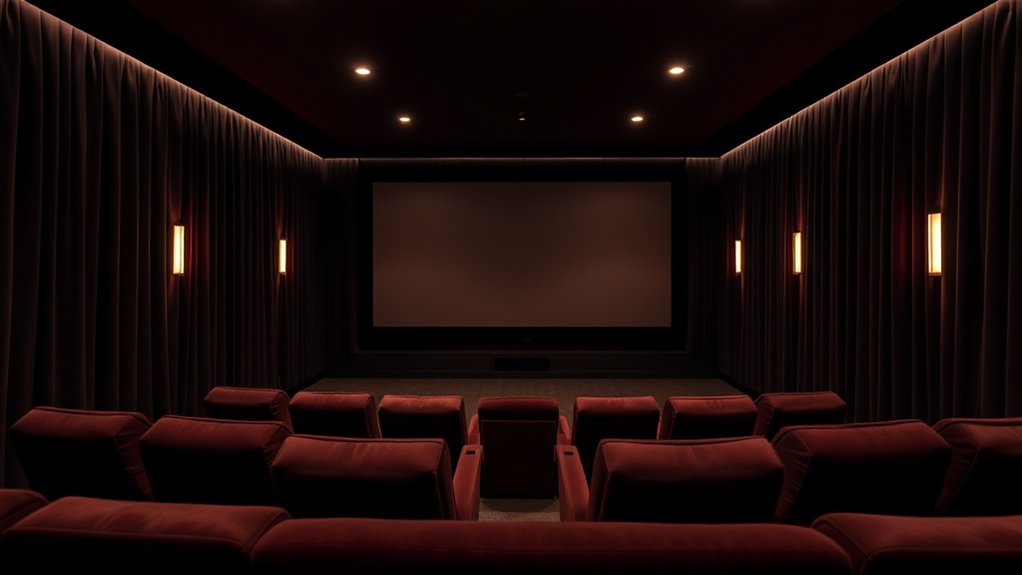For ideal theater sound, you should aim for a rectangular room with at least 250 square feet, perhaps 11 feet wide with a ceiling height of 8’6″. This shape helps reduce sound distortions, creating a better listening experience. Consider using the golden ratio for dimensions, which can help avoid frequency overlap and improve sound quality. Plus, don’t forget to arrange your furnishings wisely—it’s like setting the stage for your audio experience. Curious about how to make your space even better?
Key Highlights
- Aim for rectangular rooms to promote predictable sound wave behavior and balanced audio quality.
- A minimum area of 250 square feet is recommended for optimal sound experience.
- Adhere to the golden ratio in dimensions to avoid frequency resonance and improve sound distribution.
- Larger spaces up to 500 square feet accommodate bigger screens and seating without distorting sound.
- Incorporate acoustic treatments to control reverberation and enhance the overall auditory experience.
Importance of Room Shape in Theater Design
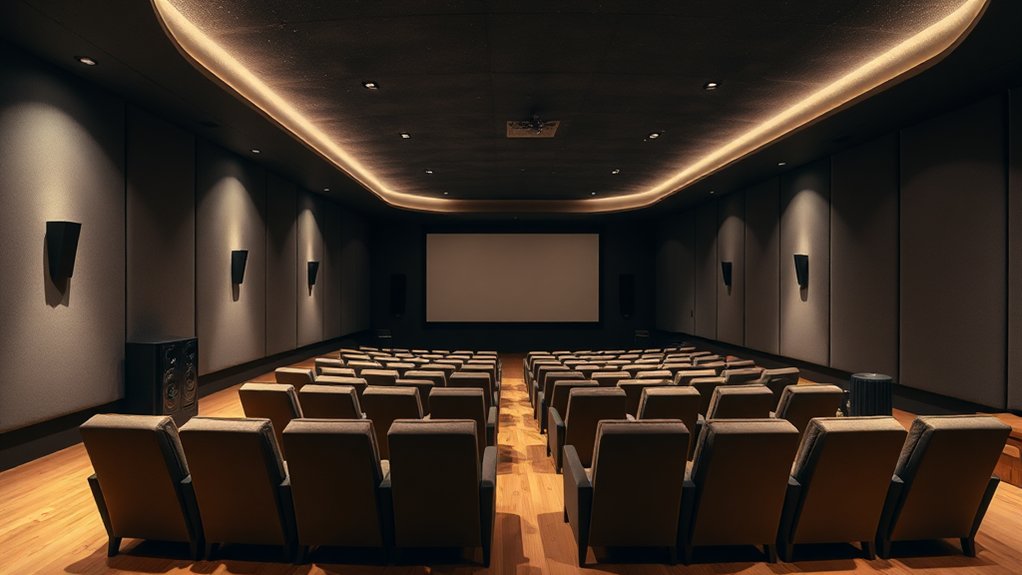
In the domain of creating an incredible home theater, the shape of your room is more crucial than you might think. A rectangular room offers predictable sound wave behavior, making it easier to enjoy balanced audio.
You wouldn’t want that boomy bass from a square room, right? Those squares often lead to resonances that muddle your listening experience. Plus, larger rectangular spaces help reduce bothersome sonic distortions. Understanding room shape can significantly enhance your audio experience by allowing for better sound distribution. Additionally, a minimum room size of 250 square feet allows for optimal seating capacity and speaker configuration, thus further elevating the sound quality. The use of advanced technologies like Dolby Atmos can further enhance your listening environment by providing an immersive, three-dimensional audio experience.
With flexible seating arrangements, you can easily optimize speaker placement for the best sound staging. So, when planning your home theater, remember, the geometry isn’t just a trivial detail—it’s fundamental to ensuring every movie night has you immersed in crystal-clear sound without irritating acoustic hiccups.
Recommended Dimensions for Optimal Sound Quality
When you’re dreaming up the perfect space for your home theater, considering recommended dimensions for ideal sound quality can feel a bit like maneuvering through a maze of numbers and ratios. To create an immersive experience, aim for a minimum area of 250 square feet, with dimensions like 11 feet wide and a ceiling height of at least 8’6”. Larger rooms—up to 500 square feet—allow for bigger screens and more seating, enhancing your viewing experience. Remember, room size shapes speaker placement, screen size, and seating configuration. Deviating from these dimensions? You may need extra acoustic treatment (hello, bass traps!). Additionally, adhering to the golden ratio can further enhance audio quality in your theater. The right room dimensions play a significant role in achieving optimal sound quality.
The Golden Ratio in Room Dimensions
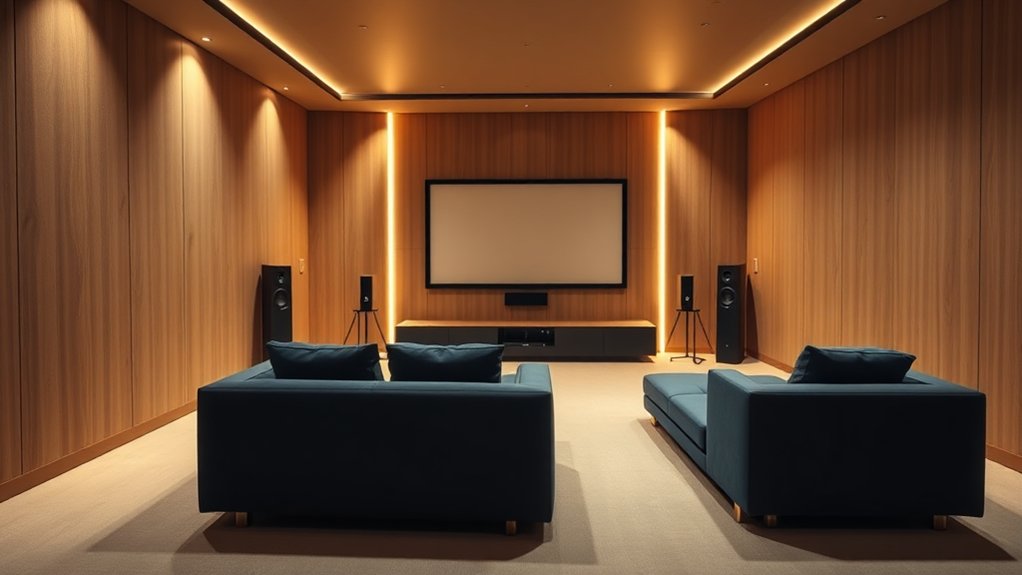
Utilizing the golden ratio in your theater room dimensions isn’t just a stroke of mathematical genius; it’s a design strategy that can dramatically improve your auditory experience.
The golden ratio, approximately 1.618, aids in evenly distributing sound during reducing those bothersome acoustic issues, like standing waves and echoes. By applying this ratio—like using length = 1.618 × width—you can guarantee that no two dimensions resonate at the same frequency, which keeps your sound crisp and clear.
For instance, if you have a 3 m ceiling height, your width should be about 4.85 m and length approximately 7.85 m. Effective dimensions lead to a better recording environment for musicians, ensuring that the sound quality reaches its fullest potential.
Who wouldn’t want a space that sounds as great as it looks, right? It’s a win-win for your ears and eyes!
Acoustic Considerations for Rectangular Rooms
Acoustic considerations for rectangular rooms play a key role in achieving superior sound quality, and understanding how sound waves interact in these spaces is essential.
In a rectangular room, sound reflections are predictable, which allows you to control speaker placement and design treatments more effectively. Unlike irregular spaces, these rooms limit unexpected acoustic anomalies, making sound more uniformly distributed across your seating area.
Nevertheless, parallel walls can lead to bothersome flutter echoes—kind of like that friend who just won’t stop repeating themselves. To mitigate this, consider varying wall dimensions slightly and incorporating acoustic treatments, which help manage standing waves and resonance.
Eventually, grasping these concepts helps you craft a space that’s not just functional but delightful for every performance.
Managing Sound With Acoustic Treatments
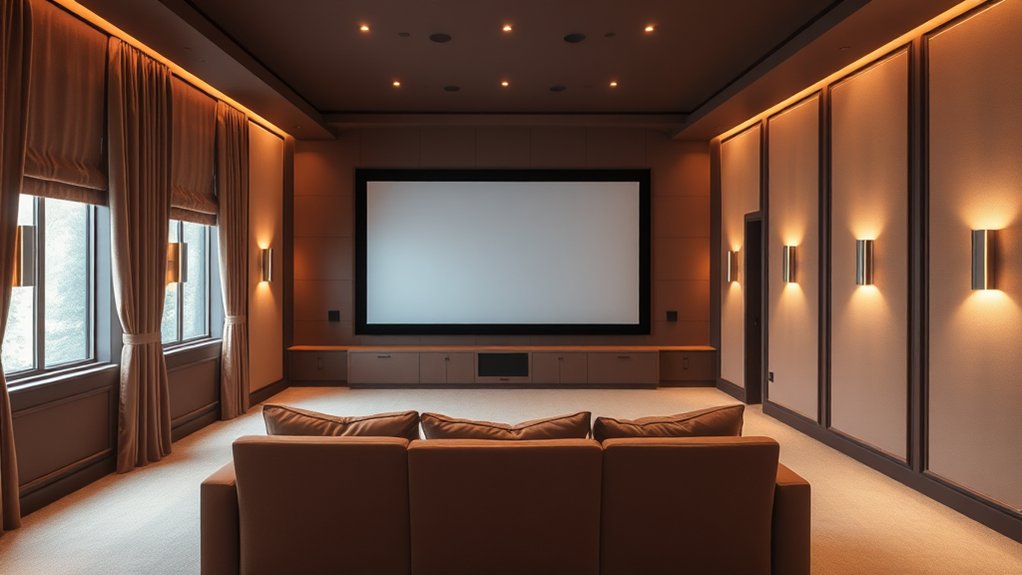
To achieve an exceptional sound experience in your home theater, managing sound with acoustic treatments becomes crucial as it fine-tunes the environment where the magic happens.
Managing sound with acoustic treatments is essential for creating an extraordinary home theater experience.
You’ll want to focus on absorption, diffusion, and bass trapping to tackle different sound reflection issues. For instance, using absorption panels made from foam or fiberglass can markedly cut down reverberation and echoes, as diffusers help create a more spacious sound field by scattering sound waves.
Don’t forget about bass traps; placing them in corners can control the low-frequency boom that often plagues home theaters.
So, a perfect balance is key—too much absorption can lead to a lifeless sound, whereas too little can make your audio experience feel chaotic.
Ain’t sound management fun?
Understanding Viewing Distances and Seating Layout
How do you guarantee everyone in your home theater gets the best possible viewing experience? Start by considering ideal viewing distances, which relate closely to your screen size. Ideally, you want your seating placed 1.5 to 3.5 times the display height away, ensuring comfy angles between 30° and 40° for immersive viewing without needing binoculars.
If you’re going for a multi-row setup, raise the back rows, or stagger them to maintain unobstructed sightlines. Don’t forget about seat types, either—recliners need a minimum of 20 inches between them.
Acoustic Principles Guiding Room Design
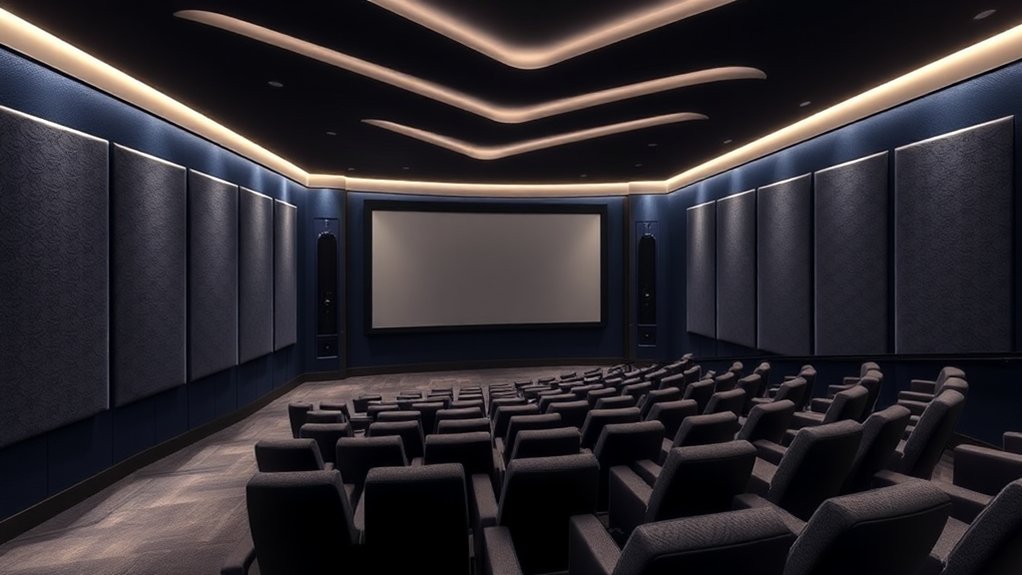
Even though most people think about the visuals when designing a home theater, the sound can make or break the experience just as easily.
To start, rectangular rooms are ideal since their symmetry promotes predictable sound behavior. If your space is irregularly shaped, you might end up battling uneven reflections, which can really spoil that immersive experience.
Keeping room dimensions away from simple multiples helps minimize those troublesome standing waves—trust me, you don’t want those ruining your bass. Speaking of bass, sloped walls can diffuse reflections just like a good diffuser does in an audio setup, preventing that irritating flutter echo.
And let’s not forget ceiling height; a moderate choice strikes a balance between clarity and spaciousness.
Sound like a plan?
Practical Tips for Enhancing Room Acoustics
Creating the perfect acoustics in your home theater is like baking a delicious cake—you need the right ingredients in the right amounts.
First, cover 60-70% of your surfaces with acoustic panels made from fiberglass or mineral wool to absorb those irritating mid and high frequencies. Don’t forget about bass traps in the corners; they’re crucial for controlling boominess! Position absorption materials at reflection points—by your speakers and where you sit—to clear up muddled sounds.
Cover 60-70% of surfaces with acoustic panels to absorb mid and high frequencies, and use corner bass traps for optimal sound clarity.
Next, adding diffusers helps scatter sound waves, avoiding those bothersome hotspots. Finally, consider soft furnishings like thick rugs and curtains; they’re not just stylish but likewise act as sound absorbers.
Isn’t it comforting to know you can transform your room into a theater haven?
Frequently Asked Questions
Can I Use Any Shape for a Home Theater Room?
Certainly, you can use any shape for a home theater room, but not all shapes are ideal. Rectangular rooms typically offer better acoustics. If necessary, add acoustic treatments to improve sound quality in less-than-ideal spaces.
How Do I Choose Seating Materials for Optimal Sound?
To choose seating materials for ideal sound, you’ll want soft fabrics like microfiber or suede, ensuring comfort and sound absorption. Avoid reflective materials to minimize echoes and improve audio clarity for a better viewing experience.
What’s the Impact of Lighting on Theater Acoustics?
Lighting improves theater acoustics by setting the mood and creating emotional connections. Although it doesn’t directly impact sound, effective design guarantees a harmonious balance, helping you engage the audience and raise the overall performance experience.
Do Windows Affect Sound Quality in Home Theaters?
Yes, windows affect sound quality in home theaters. They can create reflections and allow sound leaks, disrupting sound clarity. You should consider treatments like heavy curtains or acoustic panels to minimize their negative effects.
How Can I Improve Sound in an Existing Room?
To improve sound in your existing room, add acoustic panels to absorb excessive echoes, strategically place diffusers to balance reflections, and consider multiple subwoofers for smoother bass response throughout the space. Experiment until it sounds right.

